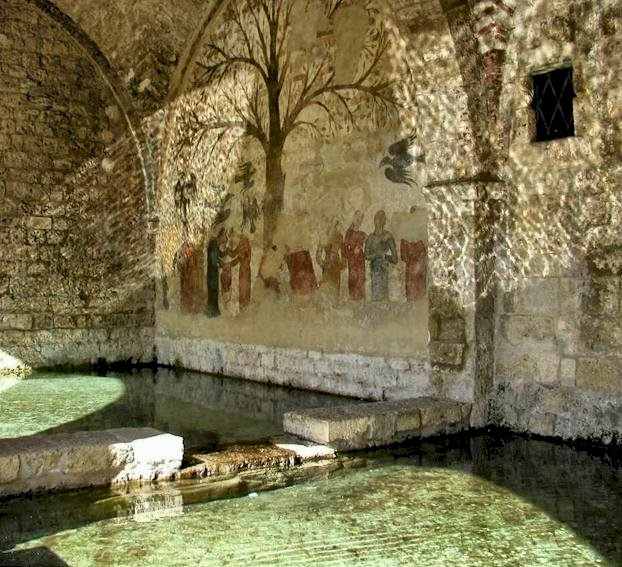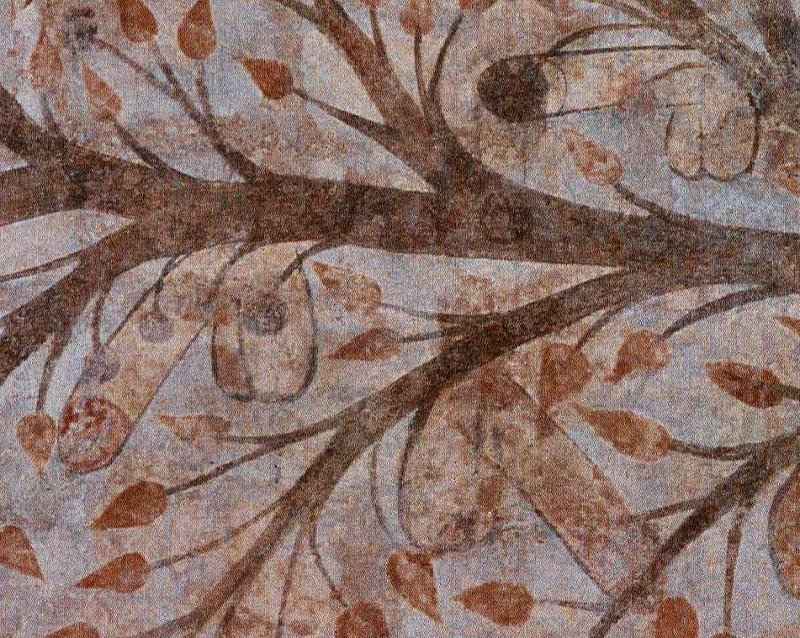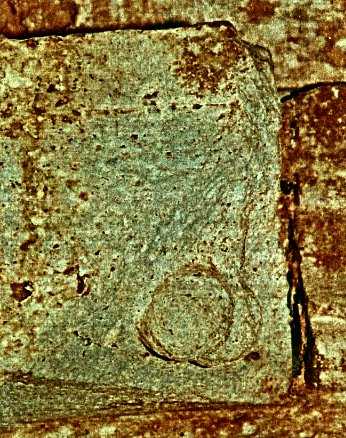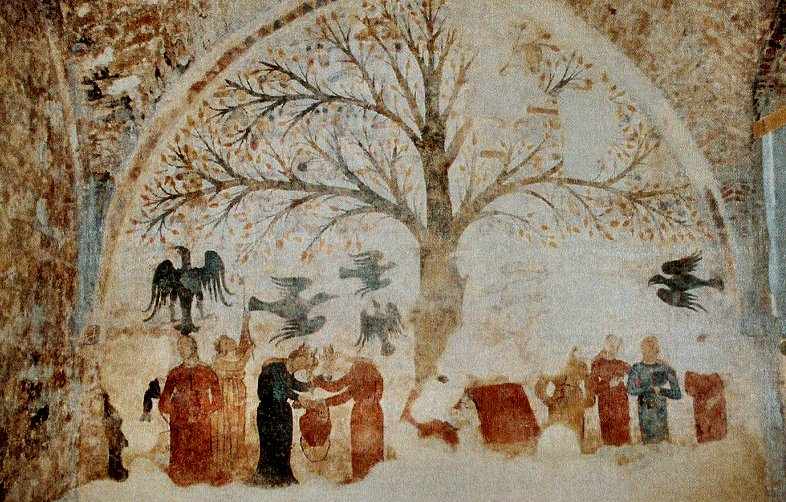Massa Marittima (Grosseto), Italy

This little inland town (which must not be confused with the coastal
city of Massa to the NNW)
has a beautiful Romanesque church where I found nothing of interest to the
exhibitionist-hunter.
Some years after my visit, however, an extraordinary mural was uncovered -
inside the town's large communal fontana
(which was in fact a bath-house), after centuries of lime-encrustation.
It dates from the late 13th century and shows a group of people and several
birds
underneath a tree which not only bears curious flowers
but also has several phalluses hanging from its branches.

|
From Fertility Symbol
to Political Propaganda - by Andrew Lawless
Luckily for the town, Ferzoco, who had chosen the town to be the annual base for his university's summer Italian programme, was immediately intrigued by the painting and its strange imagery. His research has uncovered layers of meaning that add significantly to our understanding of the popular culture of mediæval and renaissance Tuscany and Europe. According to Ferzoco's theory the painting is neither an extravagant fertility symbol, nor shocking pornography.
Background To explain the mural, one first needs to delve into the history and politics of mediæval Italy (the painting was done in the late 13th century). �Broadly speaking - Ferzoco explains - this was the time of the rise of the Italian communes, or city republics. The Northern part of the peninsula in particular was polka-dotted with these independent States. To consider it in modern terms, had there been an Olympic Games in the late 13th century there would have been a dozen or two teams from what is today Italy. Each of these city States was effectively its own nation. Some of the more famous ones are well known to even those with the most passing knowledge of mediæval or renaissance Italy, just think of Venice or Florence or Pisa, for example." In the illustrious rollcall of Italian city States, Massa Marittima may be an unfamiliar name to many. �A couple of years ago there was an award-winning, six volume encyclopedia published on the Renaissance, and you'll look in vain anywhere in those six volumes for even a vague mention of Massa Marittima - concurs Ferzoco - but in its time it was an extremely wealthy place and was completely independent from the years 1225 to 1335. It was smack in the middle of this period of independence that this mural was created. Massa got its money from an unusual source. Most of the money that financed the mushrooming of independent States came from banking, especially in the case of the Tuscan city States, and the trade in textiles. It was a different, almost unique, raw material that gave Massa Marittima its wealth and that consisted in minerals. The hills around Massa Marittima are in fact called Le Colline Metelifere, The Metal Rich Hills. In the Middle Ages there would have been about thirty different types of ore excavated, mined and refined, ranging from gold to lead. It was easily the greatest mining centre of the Italian peninsula, so anyone wanting to have these raw materials from a relatively close source would have had to, by default, deal with Massa Marittima, and hence its prestige and wealth. As a result it was highly contested. As usual it's the closest neighbours who are the peskiest ones. The ones who tried most assiduously and repeatedly to take over Massa Marittima were Pisa and Siena, and it was ultimately Siena that won the day by over-running Massa Marittima in 1335.�
The background of wealth and warfare is vital to the understanding of this peculiar mural. Painted in the town's communal fountain, the mural shows a tree covered in phalluses, with a number of eagles flying around it, and with women underneath. The location of the mural is the first key to its importance: �It was a work that was destined and intended to be seen - Ferzoco emphasises - by everyone in the town and by all visitors to the town because it was placed at the central water fountain. The water fountain alone was an extraordinary technological and sanitation feat. Most hill top towns would have had their water source well outside the walls of the city, down the slopes from the city in a low lying area. That meant that for the inhabitants of most cities to get their water on a daily basis would have to allow for quite an excursion, carrying large jugs of water, perhaps with their mules or donkeys. The actual effort involved is not slight. Even as a tourist going to a place like San Gimignano, visiting their communal water source outside the town walls, walking back up the hill, carrying nothing but a camera you'll be covered in perspiration and quite tired. Apart from that, there's another important factor when dealing with supply of water and that's enemy invasion, as for example with Pisa and Siena. Enemies trying to attack any town would first and foremost try to besiege it, and the easiest way for anyone to get a town to fall to its knees would be to get a hold of its water supply. So it was extremely difficult for these hilltop towns and city States to safeguard their water supply from attack. The extremely unusual thing about Massa Marittima was that, through their wealth and particularly through their technological expertise, developed through the construction of galleries and shafts in mining, they were able to channel water in large quantities into the very heart of their city republic, within the city walls. That meant that no-one had to walk far to get large quantities of water, and this water supply would be completely safe when enemies attacked. People wouldn't have to risk a kamikaze-style run to get water outside the walls.� So, placed in a central and prestigious location, there can be no doubt that the mural was intended for a wide audience. But what of its meaning? The fact that there are so many phalluses on display would lead one, with a modern perspective, to presume some erotic connotation. Attitudes in the Middle Ages though would not have been the same: �this was in the days before the fig leaf or the cleverly strategically placed veil of linen covering the nude genitalia in paintings, - laughs Ferzoco - The nude image was not seen to be dirty, and in the case of public art nor would it have been perceived necessarily as erotic. It would have been seen simply as a depiction of nakedness and nothing else�.
Depicting the un-natural Discounting the idea that it's simply pornography, the next obvious leap is to presume that it's a fertility symbol, surely? �The people who have said that it's a fertility symbol have made a natural and understandable leap from the images of the phallus that one can see in the tree, and the fact that since Roman and even Etruscan times, the phallus was used as a symbol for good luck and fertility�, says Ferzoco, before discounting the theory. �The fact of the matter is that there is, with regard to the phalluses on display in this painting, nothing whatsoever to do with fertility. It's one thing to have a symbol of a phallus on its own. That can stand for good luck, fertility, what have you. It's another to put it in a different context, one in which it's seen to be quite literally growing on a tree. The mediæval culture, more than ours, was one that was extremely sensitive to what was perceived as the goodness of nature, the goodness of what is natural, and they would have put two and two together in a way which involved seeing this particular tree bearing fruit that is not natural fruit. Those two elements of the equation would have added up to be something which is not natural and hence not good.� While the phalluses in the tree are, by the context, strange and shocking, there are other phalluses in the painting which add currency to Ferzoco's hypothesis that this is anything but a mural celebrating fecundity. �We have an image of two women who appear to be locked in serious combat over one of these phalluses, so this supposed fertility symbol that ought to bring life and goodness is in fact bringing strife to the people fighting over it. More importantly, there is a woman on the left side of the mural, standing in what I call her'Lady Di' pose, standing quite demurely, until you realise that she's being sodomised by one of these phalluses. You can't get pregnant by sodomy - it's the ultimate in non-fertility. There's something going on in the mural that subverts notions of fertility.� But why would one display such an extravagant, and no doubt expensive, symbol of non-fertility in such a central place? What message is it conveying? �The key to that subversion - according to Ferzoco - is shown with the symbol of one of the two competing political factions of the time, which is displayed prominently in the mural. This is the Eagle, a symbol of the Ghibelline party. The juxtaposition of this party symbol along with another symbol being used unnaturally, in a non-fertile way is meant to create in the viewer a kind of relationship between what is unnatural or not good on the one hand and the Ghibelline party on the other. It makes even more sense when you consider that during almost all of its history as an independent city republic, Massa Marittima was controlled by the anti-Ghibelline Guelph party.� The Guelph-Ghibelline conflict that raged through Germany and Italy during this period, at its simplest could be described as an ongoing conflict between the Papacy (the Guelph faction) and the Holy Roman Emperor (Ghibelline faction), though in reality the conflict had many different dimensions with local rivalries and strategic concerns playing an important role. So, in the context of Massa Marittima, controlled by the pro-papacy Guelphs, the mural becomes an example of explicit political art. Set in a publ;ic bath-house, it is a warning of the breakdown of morality which licentious Ghibelline control of the town may bring.
The fate of political art Was this kind of political painting popular during the period? Do we have other examples that would back up Ferzoco's theory? In terms of surviving paintings, unfortunately no. This, though, in itself, doesn't weaken the argument. �This is part of what is fascinating and extremely important about the Massa Marittima mural� enthuses Ferzoco. �Take current day Bologna, where there has recently been an election. There may be election posters still up around the city, but they're no longer in pristine condition. They will have been covered up or defaced, or soon will be. It's the nature of political art that it be temporary. We have documentary evidence, written descriptions of art that was intended for a political use throughout this period. We have a strong feeling that the walls of almost all these city republics would have been liberally decorated with short-term political paintings. Much of the politics involved would have been more precise, dealing with criminals. It would have been the equivalent of the'wanted' posters. It would have been quite common, near the gates of the town, for enemies of the city republic to have their likenesses painted so that, if people saw them they could recognise them and apprehend them. We know that this kind of political, or politically motivated, art was extremely common, but precisely because they are political and politically related, they didn't last. Sooner or later the political impulse which gave rise to the creation of these images would disappear and the images would thus very soon become irrelevant.� It is a historical irony that the mural survived. �It has survived in the way that many outstanding artistic monuments have come through to us. Not long after it was at its height of wealth, the town very quickly became an incredibly poor place. It's similar to San Gimignano. San Gimignano has all the towers that it has got today almost purely due to the fact that it was not long after these towers were built, that the town was largely abandoned. Its location and the general power struggle in the region at that time meant it wasn't worth anyone's while to come in and knock down these towers that had been built as a kind of natural defense system as well as a status symbol. No-one cared, so they remained as they were. In the case of Massa Marittima this painting survived because at some point, and it's impossible to know when, it was at first altered and then whitewashed. The first stage of alteration had to do with the removal of the phalluses from the painting. I've spoken with the man who did the restoration, a fascinating man who's been in the business since the 1950s. He told me that when he was scraping the layers of lime and whitewash off the mural that he found these large flowers on the trees, and underneath these flowers he eventually found the phalluses. The flowers covered over the fact that this was an un-natural tree, a tree of evil, and it just became a decorative tree. Then it got painted over. Over the centuries, because it was painted at the fountain, and because Massa's water supply is extremely rich in lime, not surprisingly due to the quantity and diversity of metals in the hills, this lime just got attached to the walls so that gradually all memory of the image disappeared. It was only by pure chance that it was re-discovered and restored in 2000�. Ferzoco has been unable so far to find reference to the mural in any surviving documents from the period, which remains a puzzle for him. �One can never say never and I hope one day to find documents relating to it, but the coeval documents that I've examined to date and ones that I've looked at from later periods as well make absolutely no mention of this painting, which on the one hand is surprising as it would certainly have cost the comune a pretty penny to have painted. At some time or other, there must have been documentation relating to the payment of artists for it. Also you would have thought a painting, at least so striking to us would have been mentioned somewhere, but so far nothing. It took the discoverers and restorers of this image completely by surprise. No-one had expected such an image existed�.
Witchcraft To say that no-one had expected such an image existed is not strictly speaking true. An obscure passage in Europe's most famous witch hunting manual, the Malleus Maleficarum, published in the late 15th century has long puzzled researchers, referring bizzarely to a practice where a witch would cut off a man's genitals and bring it to a prepared nest, in a tree, where the phallus would be placed, and from whence it would grow on the tree. If one looks carefully at the Massa Marittima mural, one of the women is prodding a nest on one of the branches of the tree. Ferzoco is convinced that the Massa Marittima mural is one of the earliest depictions of witchcraft surviving from mediæval Europe: �One must always be careful of saying'the first ever', as it's a guarantee of something earlier popping up, but I have been looking very extensively, and I've consulted widely with scholars who are very well informed about the history of images of witchcraft and there's not one uncontestable image of a witch that comes remotely close to this one chronologically speaking. The fact that this woman is prodding a nest in a tree has gone almost completely unnoticed. This is partly because the nest is not easily seen, and partly because as one glances at the image one gets more the impression that she's waving the stick to scare away the birds that are circling around, or perhaps that she's reaching up to the tree to shake down some of the fruit for herself. But the connection of the woman with the nest is extremely important. The tree in the Massa Marittima mural seems as if it was painted to describe this chapter, it fits it so perfectly. The tree shows, at least what is visible to the naked eye since it was uncovered in 2000, 25 phalluses [according to the passage in the Malleus Maleficarum, between 20-30 phalluses could grow on one tree]. Again let's recall, the appearance of phalluses in a tree was seen not to be natural so these phalluses would somehow have been placed there. Twenty-five of them in a tree, and in the same painting there is a bird's nest being breached by a woman. The connection, in light of this obscure chapter from the witchhunting manual becomes painfully obvious. We've got here a witch in the process of getting a nest so it could serve as a new home for a phallus taken from one of the unlucky men from the town." There is much more research to be done on this fascinating mural, but the citizens of Massa Marittima can breathe easy, thanks to Ferzoco's research, knowing that their town is the home to a unique and important piece of art, rather than a dirty painting best covered up.
George Ferzoco is the director of the Centre for Tuscan Studies at the University of Leicester. His work, The Mural at Massa Marittima was recently recognized with a prize by the Society for mediæval Feminist Scholarship. The Massa Marittima Mural by George
Ferzoco is published by the Regional Council of Tuscany in association
with
|

A stone capital elsewhere in the bath-house.
Click here for a post-Romanesque female exhibitionist in Milan.
 In the year 2000, during restoration work,
a rare and important mural was uncovered at the communal bath-house
or 'fountain' of the Tuscan town of Massa Marittima. It was
not necessarily a welcome surprise, at least at first, as this painting
from the Middle Ages depicted a tree covered with phalluses. �At first
when the painting was discovered they were a bit taken aback�, explains
George Ferzoco, the director of the Centre for Tuscan Studies at the
University of Leicester, about the general reaction of the townspeople
and administration. �They considered it to be somehow dirty or erotic
- he continues - one or the other. Those who saw it as erotic looked
at it as being a symbol that mirrored the reality of the water and the
place. Water gives life; Phalluses give life: Isn't this a unique
and interesting way to portray the life-giving properties of water?
The porn camp, if we can call it that, saw it as being somehow deliberately
obscene and thus believed that as little attention as possible needed
to be drawn to it�.
In the year 2000, during restoration work,
a rare and important mural was uncovered at the communal bath-house
or 'fountain' of the Tuscan town of Massa Marittima. It was
not necessarily a welcome surprise, at least at first, as this painting
from the Middle Ages depicted a tree covered with phalluses. �At first
when the painting was discovered they were a bit taken aback�, explains
George Ferzoco, the director of the Centre for Tuscan Studies at the
University of Leicester, about the general reaction of the townspeople
and administration. �They considered it to be somehow dirty or erotic
- he continues - one or the other. Those who saw it as erotic looked
at it as being a symbol that mirrored the reality of the water and the
place. Water gives life; Phalluses give life: Isn't this a unique
and interesting way to portray the life-giving properties of water?
The porn camp, if we can call it that, saw it as being somehow deliberately
obscene and thus believed that as little attention as possible needed
to be drawn to it�. 
